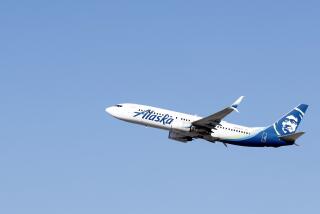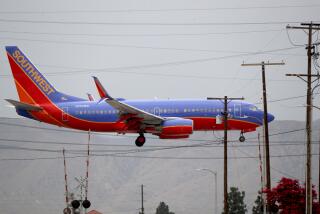Warning Signals
Before deregulation of the airlines in 1978, the federal government allocated routes and had a veto power over ticket prices. Deregulation has been a windfall for consumers in economic terms, because competition has produced sharply lower special fares between major cities. But cheaper fares cannot be allowed to compromise safety.
Airline officials say that flying is by far the safest means of long-distance travel, and so far the record supports that view. But there is growing concern that the airlines are cutting corners on maintenance while federal safety enforcement is deteriorating because of budget cuts.
Times staff writers Richard E. Meyer and Ralph Vartabedian, aided by professional air-safety analysts retained by The Times, spent months investigating whether the concerns are justified. The verdict, published today: They are.
Commercial airâs safety record actually improved from 1980 through 1984. But 561 people died in U.S. airline accidents last year, the second-highest one-year toll on record. And many industry observers fear that the potential for disaster is rising sharply because of the combined effects of deregulation and the budget squeeze.
Thanks in large part to deregulation, the number of air carriers has grown from 237 to 526 since 1979. This means that more planes are flying for more airlines. Because planes are kept in service longer, the average age of planes is going up. There is nothing inherently unsafe about older airplanes if they are scrupulously maintained. It is especially important to watch for cracks that appear after a plane has made a few thousand flights.
At a time when more emphasis on maintenance is needed, however, the airlines are in fact spending less money on maintenance per flying hour than they were before. They are making do with substantially fewer mechanics. Because of competitive pressures to meet schedules and minimize maintenance time, they tend to let seemingly non-crucial defects go longer without repairs. Airlines are lobbying the Federal Aviation Administration to allow even more time between major component inspections or replacements.
During the same period, budgetary pressures have cut the ranks of federal safety inspectors. The force of specialists who maintain and repair the FAAâs radar and other air-traffic-control facilities has declined. In short, the FAAâs enforcement capacity has fallen at the very time it should have been rising.
The airlines deny that competition is eroding safety, and they point out that they are doing more preventive maintenance and taking other steps to get more mileage from maintenance dollars.
The argument is not convincing. An intensive federal inspection of more than 300 airlines found a âhigh rateâ of non-compliance with the FAAâs standards. Of 43 airlines that were looked at more closely, 16 were penalized for infractions. The FAA has levied heavy fines against one major airline, and is proposing similar penalties against two more.
Several congressional subcommittees are looking into the air-safety situation, but already the case is clear for action on several fronts.
The federal government canât really get into the business of telling airlines how many mechanics to hire and how to use them. But it can set strict safety standards and hold airline managers strictly accountable for meeting them.
Congress and the Administration must recognize that air-safety enforcement is one area in which budget-cutting is simply unacceptable. The FAA must hire more air-traffic controllers, safety inspectors and navigation-facility maintenance personnel than now planned. The agency must also tighten its reporting requirements on structural defects and other maintenance problems. The minimum standards for qualifying as an airline pilot should be raised; cost-cutting has caused a drop in the average experience level in the cockpit. There should be stricter financial and technical standards for new airlines.
Finally, there is no denying the fact that the strains on the nationâs air-safety system are mostly the product of airline deregulation. It may be premature to call for an end to that national policy, but the issue should by no means be considered closed.
More to Read
Inside the business of entertainment
The Wide Shot brings you news, analysis and insights on everything from streaming wars to production â and what it all means for the future.
You may occasionally receive promotional content from the Los Angeles Times.










